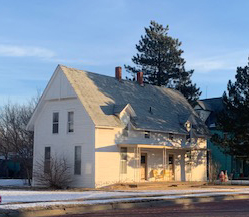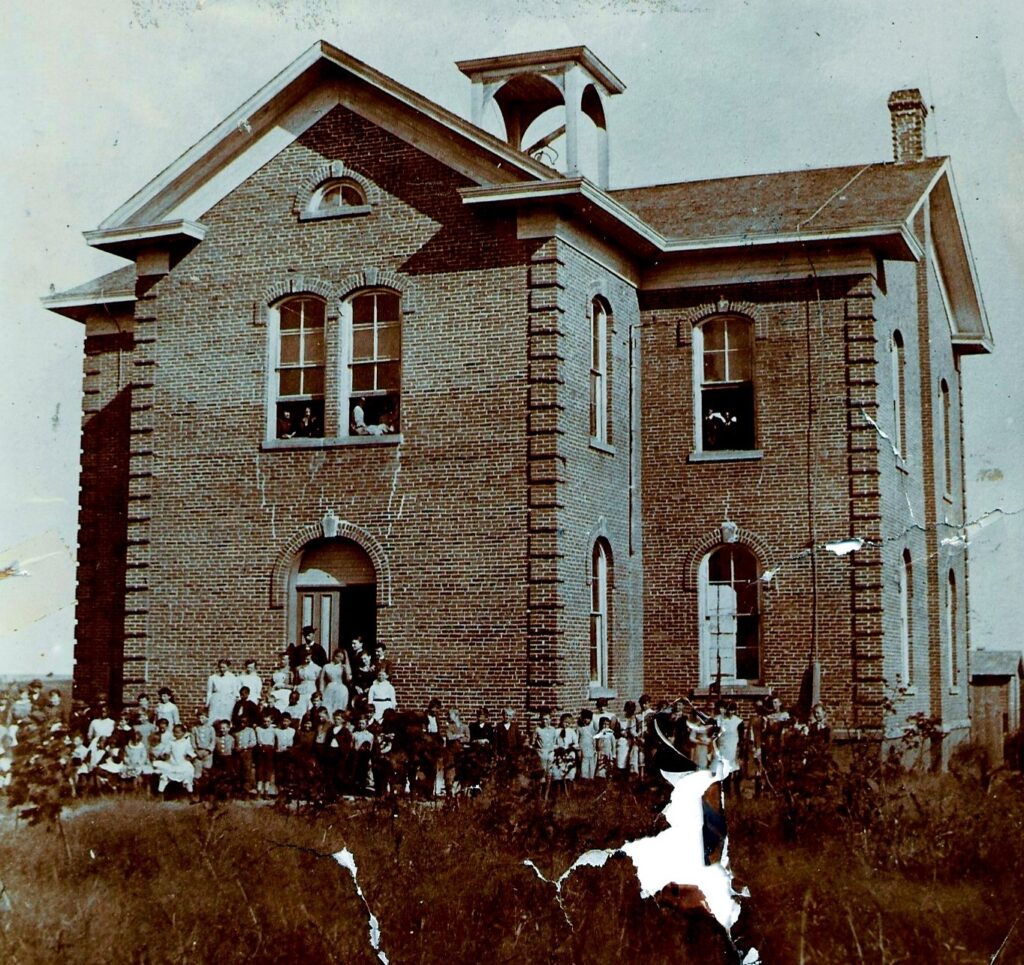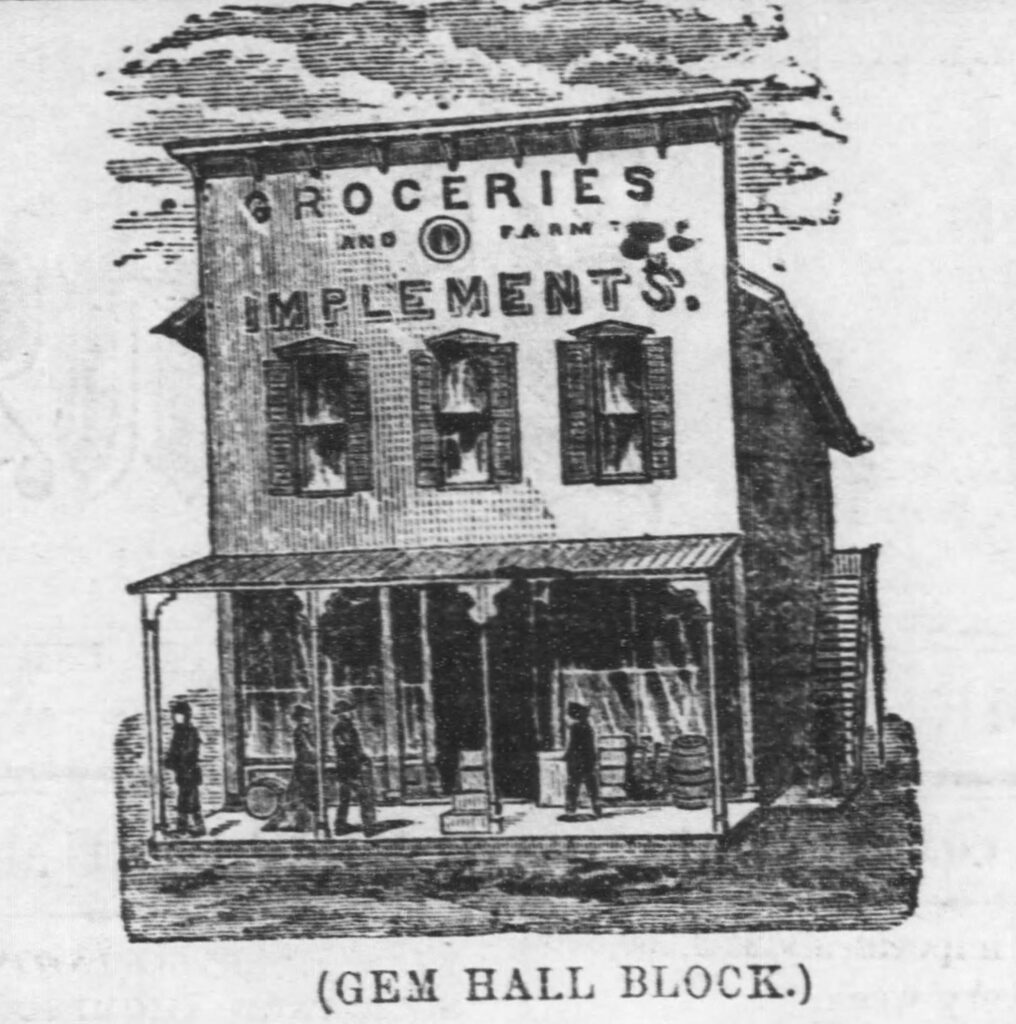It’s not surprising that Christmas has been celebrated in Kinsley since its founding in 1873. In the early years, Christmas Eve or Christmas night was reserved for a community celebration.
In 1876, everyone came together on Christmas night at the only church building in town, the Congregational Church. It was built in 1875 and was located on the northwest corner of N. Third Street and Massachusetts with the main doors facing east. This building still stands at its present location, 426 E. Sixth St. The church entrance now faces west.

This event hosted the very first community Christmas tree. James A. Walker, who would later write an early history of Edwards County, impersonated Santa Claus. The 6 o’clock program included “music, recitations, a fish pond and a post office” (Kinsley Reporter, December 1, 1876).
The next year, the Union Sabbath School invited everyone to a social on Christmas Eve at the new two-story brick school house on the corner of First St. and Colony Ave. This celebration was free, with entertainment and something given to all the children. (December 13, 1877, Edwards County Leader)

The December 21, 1878 issue of The Valley Republican reveals that the deep snow did not interfere with country people getting to town to prepare for and celebrate Christmas. The paper mentions a sleigh drawn by four horses, Jacob Schmidt’s ice house being filled with ice (cut from Coon Creek?) measuring a foot in thickness, and the buffalo bone business being postponed until the snow disappears.
We read in the next issue how the community celebrated on Christmas Eve at “Gem of the Valley Hall” which was located on the second floor of the Depuy and Frater implement store (about 217 E. Sixth, Bossy Sister location).

The headline reads, “Gem Hall was packed with Lively Children, Beautiful Women and Passable Men.” The event was described as a great success. “Gem Hall was brilliantly lighted and packed to its utmost capacity. Every available seat and standing room was occupied…. One large tree reached from the floor clear to the high ceiling, and was flanked by two small ones. All were dazzlingly brilliant with their variegated assortment of pendant presents.”
After the singing of some carols and a speech, “Santa Claus came prancing into the room to a jingle of sleigh bells and amid the shouts of the children, and at once commenced the distribution of presents. Each scholar received a stocking full of candy and an apple. Many valuable and beautiful articles were distributed among happy recipients, and there were but few who did not get something.”
On that night a touching poem entitled “Annie and Willie’s Prayer” by Sophia P. Snow was read. It was printed in the Edwards County Leader on December 26, 1878. You can hear a beautiful reading of it by poet Neil Stewart McLeod: https://www.youtube.com/watch?v=2kLnvHUcSH8 or view printed link.
As everyone knows, early in Charles Dickens’ “A Christmas Carol” we boo the villain Scrooge for not wanting to give Bob Cratchit a holiday on Christmas Day. But what I learned in the Valley Republican was that in Kinsley, “The stores all closed Christmas at twelve o’clock”, which made Christmas just a half-day holiday. The rest of the day, “Most of our citizens lay on sofas Christmas afternoon, wishing they had not eaten so much dinner.”
On April 19, 1879, most of downtown Kinsley’s wooden store buildings, including Gem Hall, were destroyed by fire. On December 23, 1879, in a newly rebuilt Calkin’s Hall (located about 203 E. Sixth St), the last unified Christmas program was held. In years to come, the churches would begin hosting their own programs on Christmas Eve.
Kinsley was growing rapidly and these reflective words W. R. Davis, the editor of the Valley Republican, might still hold meaning for us today. “From that time (1876) until the present (1879) the rush of immigration has greatly changed the sociability of the gatherings of ye olden times. Strange faces and new customs follow the settlement of a new country…. The order of exercises were new, the names called to come forward for presents were strange…. yet it is a pleasant thought that with the newcomers come Sunday School workers and Christian people. Long may our people live and prosper, and with each Christmas may there be no mistakable evidence on an advancement of all that is good and pertains to the elevation of humanity.”
